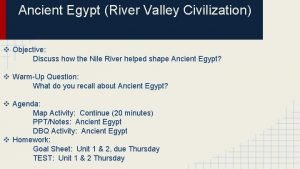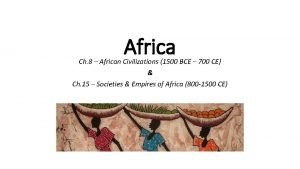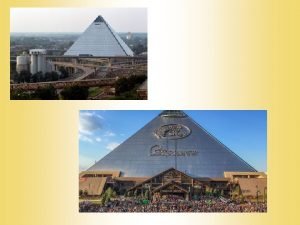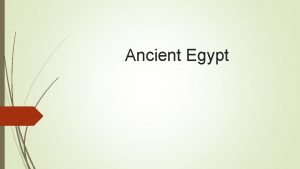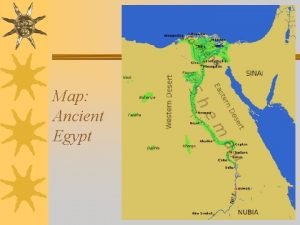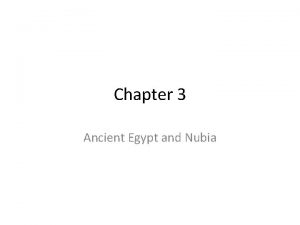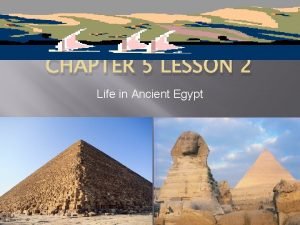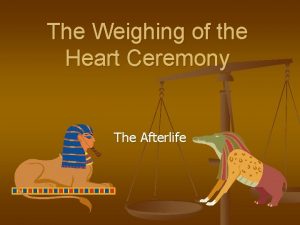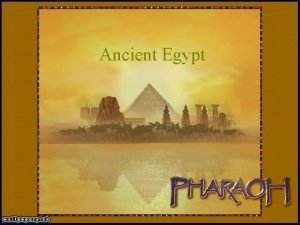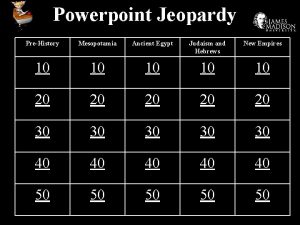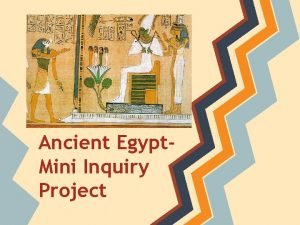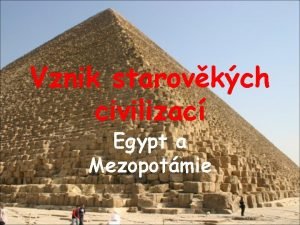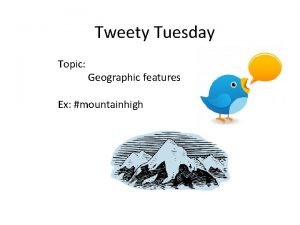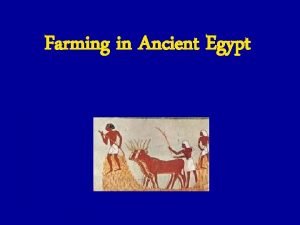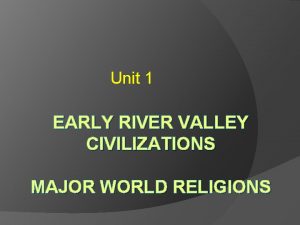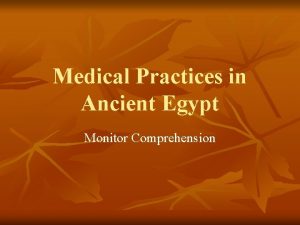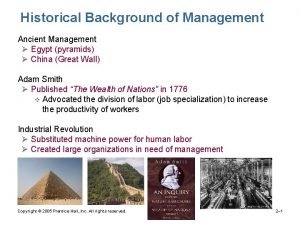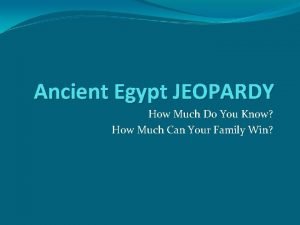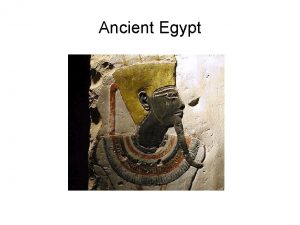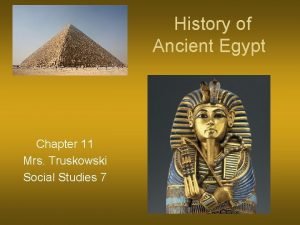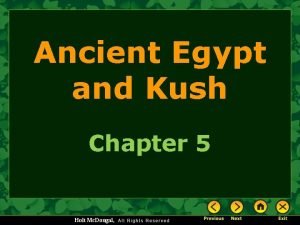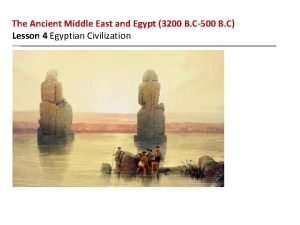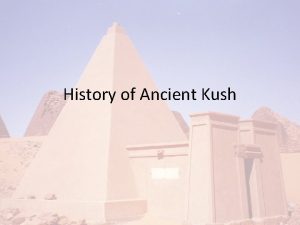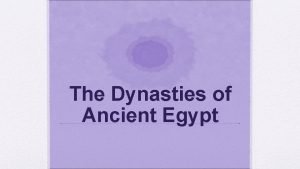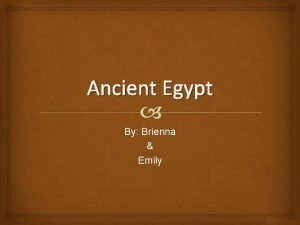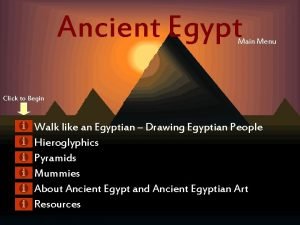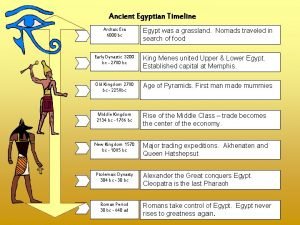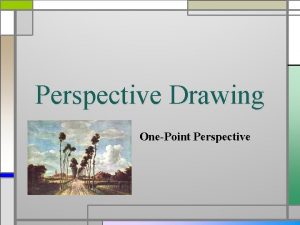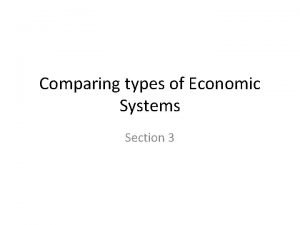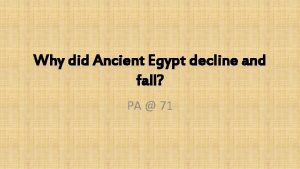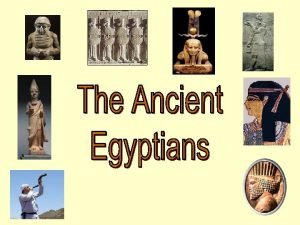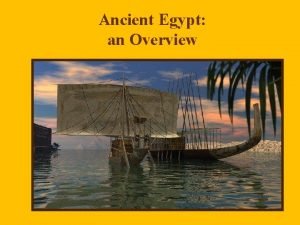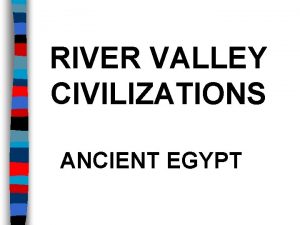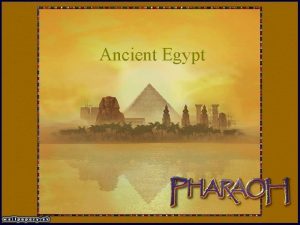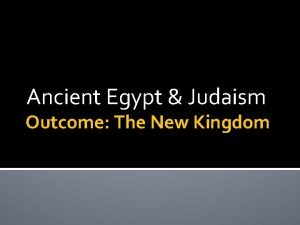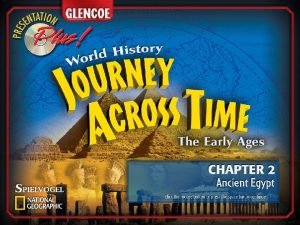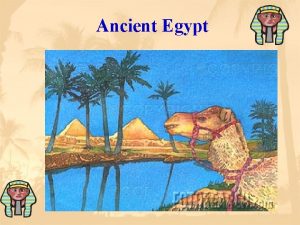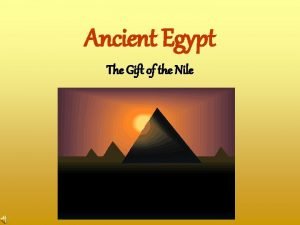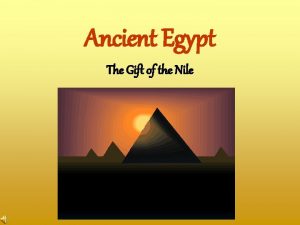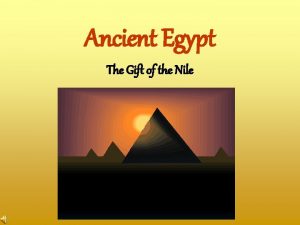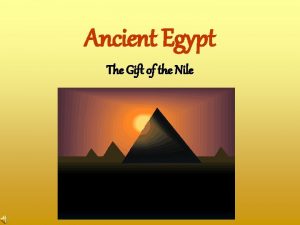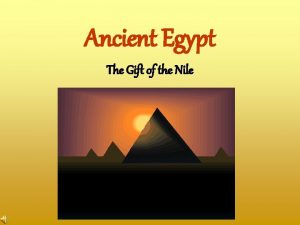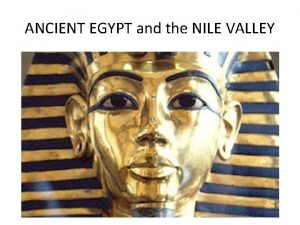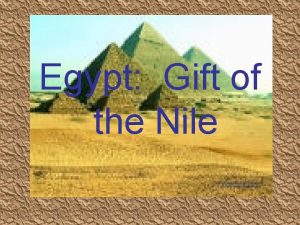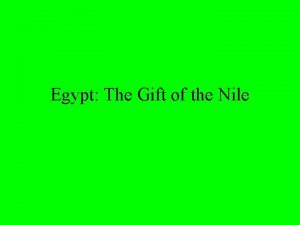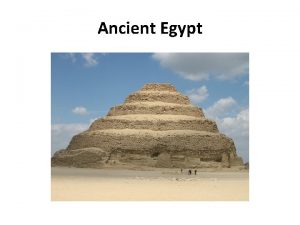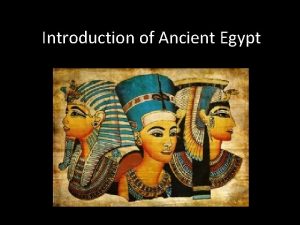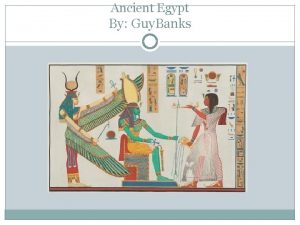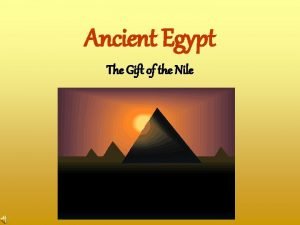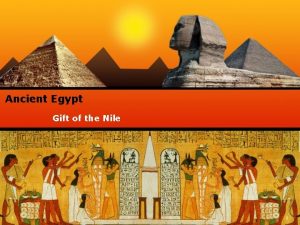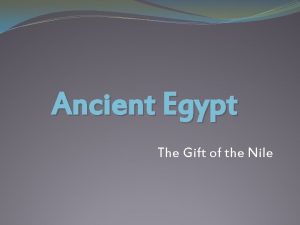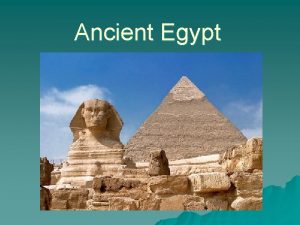Ancient Egypt The Gift of the Nile WHAT




























































- Slides: 60

Ancient Egypt The Gift of the Nile

WHAT IS A CIVILIZATION?

Neolithic Revolution

What is a society? • A group of people living together, dependent on one another, is a society. • There are no other requirements to make asociety. • We are not studying societies in class this year. • We are studying civilizations. • Civilizations are a society in an advanced state of social development. • What do we mean when we say an advanced state of social development? • There are 5 Key Elements that make a society advanced enough to be considered a civilization.

Centralized Government • A person or group of people who make and enforce laws in a society.

What does Centralized mean? • Power must be concentrated in a central location and in the hands of a relatively small group of people. • In the United States, power is centralized in Washington, DCin the hands of the President, Congress, the Supreme Court and their representatives.

Organized Religion • A belief in some sort of higher being or beings. It must be organized, which means that there are specific rules and requirements for worshipping. (Clockwise from upper left) Islam, Taoism, Hinduism, Christianity, Buddhism, Sikhism, Judaism

Job Specialization and Social Classes • Job Specialization is when the members of a society have specific jobs to do and are not expected or required to do every job necessary to survive. • Social classes are ways in which people are divided based on their social, economic, or educational status.

Arts, Architecture, and Infrastructure • Arts are a way that a society expresses its values and beliefs in a creative way such as painting, dancing, or playing music. • Architecture describes the ability of a society to design and build large structures. • Infrastructure are structures created by a government for the good of the common people, such as schools, roads, or parks.

Writing • A method of using symbols to keep records.

5 Key Elements of Civilization • Centralized Government • Organized Religion • Job Specialization and Social Classes • Arts, Architecture, and Infrastructure • Writing

By the end of this presentations be sure to describe Egypt’s 5 parts of civilization

Egyptian Timeline • Old Kingdom (2700 -2150) – Hieroglyphics and religion develop in Egypt – pyramids built • Middle Kingdom (20401786) – extension of Egyptian control into Nubia • New Kingdom (1570 -1075) – militaristic - Hebrews enslaved – mummification perfected

Outline 1. Geography 2. Religion – – – Gods Pyramids Mummies 1 2 3 4 5 6 3. Government – The Pharaoh 4. Daily Life 5. Middle Kingdom 6. New Kingdom

I. Geography • River dominates Egyptian world/thought • Surrounded by desert with occasional oasis – Permits some trade – Defense from invasion • Contributes to feeling of safety – preserves artifacts 1 2 3 4 5 6

“Egypt is the gift of the Nile” -Herodotus 1 2 3 4 5 6

1 2 3 4 5 6

I. The Nile • yearly flooding - no concern for soil depletion – Predictable – Irrigation systems • Encourages – Trade – Communication – Political unity 1 2 3 4 5 6

I. The Nile 1 2 3 4 5 6

I. The Nile 1 2 3 4 5 6

I. The Nile

I. The Nile • Impact on religion – divided life - living and dying. • East (sunrise) is land of the living - cities, temples • West (sunset) is land of the dead - tombs 1 2 3 4 5 6

II. Religion • Omnipresence of religion • Polytheistic – interaction with the natural environment shows interrelated gods and goddesses yearly rebirth of Nile and daily rebirth of sun – over 2000 gods • Pharaoh as living god • Afterlife – Evolution of who has an afterlife • Old vs. New Kingdom 1 2 3 4 5 6

II. Osiris • God of the Dead - “rebirth” - and the weighing of the heart 1 2 3 4 5 6

II. Horus • Horus, god of balance and harmony • maintained the natural order: the flow of the Nile and the fertility of the soil. 1 2 3 4 5 6

II. Early Pyramids Zozer’s stepped pyramid - similar to Babylonian ziggurats 1 2 3 4 5 6

Why build Pyramids? • Belief in the afterlife demanded: 1. Bodies be interred whole 2. Material goods for use in afterlife be present • The need to protect the bodies demands good burial tombs 1. First were mastabas 2. Then pyramids 3. Then later… hidden tombs

Mastaba

II. Great Pyramid • Tomb for Khufu • an almost perfect square (deviation. 05%) • Orientation is exactly North, South, East West • 2, 300, 000 blocks, 500 ft high • 20 years to build • Average block weighs 2. 5 tons – Some weigh 9 tons! 1 2 3 4 5 6

1 2 3 4 5 6


1 2 3 4 5 6

Pyramids of Menkaure, Khafre and Khufu 1 2 3 4 5 6 Queen Pyramids in front

1 2 3 4 5 6

II. Mummies • Not known when it started in Egypt • Perfected by time of New Kingdom • How to make a mummy: 70 steps – 1) Removal of the brain through the nostrils 2) Removal of the intestines through an incision in the side 3) Sterilization of the body and intestines 4) Treating, cleaning, dehydrating the intestines 5) Packing the body with natron (a natural dehydrating agent) and leaving for 40 days 6) Removal of the natron agent 7) Packing the limbs with clay or sand 8) Packing the body with linen (soaked in resin), myrrh and cinnamon 9) Treating the body with ointments and finally wrapping with a fine linen gauze, not less than 1000 square yards. 1 2 3 4 5 6

Canopic Jars made of alabaster for storage of heart, stomach, intestines and liver which were also treated 1 2 3 4 5 6

Mummy Inner coffin 1 2 3 4 5 6

Second inner coffin lid 1 2 3 4 5 6

Funerary Gifts Gift bearers Shawabti box Model boat 1 2 3 4 5 6

1 2 3 4 5 6

III. The Pharaoh • God-King - unlike Mesopotamia – Temporal power • owns all the land people and what people posses • law vs. Pharaoh's will • irrigation • no city walls 1 2 3 4 5 6

III. The Pharaoh • God-King - unlike Mesopotamia – Religious • direct descendant of the Sun god • controls access to the afterlife • July-Sept, during floods life is controlled by the Pharaoh – 365 day calendar. 1 2 3 4 5 6

III. Role played by size in Egyptian Artwork 1 2 3 4 5 6

IV. Daily Life in Egypt • Cosmetics, cleanliness (bathe 3 times a day), shaved bodies, wigs • main food is beer and bread – Grow many crops: emmer, barley, flax, lentils, onion, beans, and millet • common building made of sun-dried mud bricks - up to three stories in height • Four social classes - slaves on the bottom • Most common job … farming 1 2 3 4 5 6

IV. Farmers in Egypt 1 2 3 4 5 6

IV. Hieroglyphics • Language is written without vowels • Different pronunciations – MNFR as Memphis – SR as Osiris – TTMS as either Thutmose, Thutmosis, Tatmusa or Atithmese • Who learns this writing style? 1 2 3 4 5 6

IV. Hieroglyphics • Use in temples • Rosetta Stone • Napoleon and Egyptology. 1 2 3 4 5 6

IV. Egyptian Artwork Stela (carved stone) Egyptian Farmers & animals Notice, all people drawn from the side – even when looking right at you! 1 2 3 4 5 6

V. Middle Kingdom 2050 -1750 BCE • End of civil wars, farming and trade return • move capital south to Upper Egypt (Thebes) • public improvements – drain swamps, canal to Red Sea • belief in afterlife expands to include common people • tombs instead of pyramids – better protection for mummies. 1 2 3 4 5 6

V. Middle Kingdom 2050 -1750 BCE 1 2 3 4 5 6

VI. New Kingdom 1550 -1075 BCE • Ahmose I expelled the invading Hyksos and reunited Egypt • Known as the Empire period • development of “public” and “private” zones at temples. 1 2 3 4 5 6

Ahmose I leading Egyptians against the Hyksos 1 2 3 4 5 6

VI. New Kingdom 1550 -1075 BCE • Characterized by a more militaristic and imperialistic nature – incorporated chariot, bronze working, horses – development of a professional army • became a slave based economy fueled by war and expansion 1 2 3 4 5 6

VI. Threats to Tradition • Amenhotep IV (c. 1362 -1347 B. C. ) introduced the worship of Aton, god of the sun disk, as the chief god and pursued his worship with enthusiasm. • Changed name to Akhenaten (“It is well with Aton”) • He closed the temples of other gods and especially endeavored to lessen the power of Amon-Re and his priesthood at Thebes. 1 2 3 4 5 6

VI. Threats to Tradition 1355 -1335 BCE • Nefertiti – Wife of Akhenaton the only pharaoh to even partially reject polytheism – political move against priests of Amon-Re – moved capital to Amarna – worshipped Aton, the sun disk • royal inbreeding. 1 2 3 4 5 6

VI. Tutankhamen 1335 -1325 BCE • (King Tut) • child ruler • ruled nine years, died at 18 • young death meant burial in the tomb of a lesser person (noble) resulting in preservation 1 2 3 4 5 6

VI. Ramses II (1279 -1213) • greatest New Kingdom ruler • military leader of Egypt • expanded into southern Turkey • built many monuments to himself • last gasp of Egyptian power. 1 2 3 4 5 6

VI. Ramses II (1279 -1213) 1 2 3 4 5 6

VI. Ramses II (1279 -1213) 1 2 3 4 5 6

Why did it last so long? • Ancient Egypt lasted for 3500 years due to factors in: • Geography • Politics • Social structure • Education • Economy • Religion = Stability was goal and change slow and cautious
 Egypt is the gift of the nile
Egypt is the gift of the nile How did the nile shape ancient egypt essay
How did the nile shape ancient egypt essay How did the nile shape ancient egypt dbq answer key
How did the nile shape ancient egypt dbq answer key Aksum had access to the red sea blue nile and white nile
Aksum had access to the red sea blue nile and white nile Upper egypt and lower egypt
Upper egypt and lower egypt Fun facts for greece
Fun facts for greece Ancient egypt advanced cities
Ancient egypt advanced cities Outline map of ancient egypt
Outline map of ancient egypt Map of ancient egypt and nubia
Map of ancient egypt and nubia Egyptian social pyramid
Egyptian social pyramid Weighing of the heart ceremony ancient egypt
Weighing of the heart ceremony ancient egypt Geographical map of ancient egypt
Geographical map of ancient egypt Ancient egypt jeopardy
Ancient egypt jeopardy Economy of ancient egypt
Economy of ancient egypt Kleopatra hrobka
Kleopatra hrobka Ancient egypt british council
Ancient egypt british council Ancient egypt medicine
Ancient egypt medicine Ancient egypt social structure
Ancient egypt social structure What crops did the ancient egyptian farmers grow
What crops did the ancient egyptian farmers grow Ancient egypt drawings easy
Ancient egypt drawings easy Ancient egypt civilization
Ancient egypt civilization Medical practices in ancient egypt answer key
Medical practices in ancient egypt answer key What is historical background of management
What is historical background of management Ancient egypt bell ringers
Ancient egypt bell ringers English georgian period floral design
English georgian period floral design Ancient egypt jeopardy
Ancient egypt jeopardy Egypt social hierarchy
Egypt social hierarchy Chief god of egypt
Chief god of egypt Disadvantages of ancient egypt geography
Disadvantages of ancient egypt geography Specialized jobs in ancient egypt
Specialized jobs in ancient egypt Timeline of ancient egypt
Timeline of ancient egypt Ancient egypt pyramid of power
Ancient egypt pyramid of power Egyptian linen clothing
Egyptian linen clothing Map of egypt and kush
Map of egypt and kush Social hierarchy ancient egypt
Social hierarchy ancient egypt Map of ancient egypt and kush
Map of ancient egypt and kush Relative location of cairo egypt
Relative location of cairo egypt Egypt vocabulary
Egypt vocabulary Ancient egypt bell ringers
Ancient egypt bell ringers Ancient egypt basic needs
Ancient egypt basic needs What is frontalism
What is frontalism Fomro
Fomro Egyptian religion timeline
Egyptian religion timeline artists use this perspective to show objects face-on.
artists use this perspective to show objects face-on. Economy of ancient egypt
Economy of ancient egypt Non chronological report about egypt
Non chronological report about egypt Why did ancient egypt fall
Why did ancient egypt fall Ancient egyptian transportation
Ancient egyptian transportation Ancient egypt slogans
Ancient egypt slogans Ancient egypt civilization geography
Ancient egypt civilization geography Three kingdoms of egypt
Three kingdoms of egypt Egyptian frontalism art
Egyptian frontalism art Specialized workers in egypt
Specialized workers in egypt Egypt map
Egypt map Ancient egypt and judaism outcome the new kingdom
Ancient egypt and judaism outcome the new kingdom Ancient india vs ancient china
Ancient india vs ancient china Ancient means of communication pictures
Ancient means of communication pictures Nile floodplain
Nile floodplain A section of the nile river with rapids and rocky terrain
A section of the nile river with rapids and rocky terrain Guided reading activity 2-1 the nile valley answer key
Guided reading activity 2-1 the nile valley answer key Leon ridgeway
Leon ridgeway


